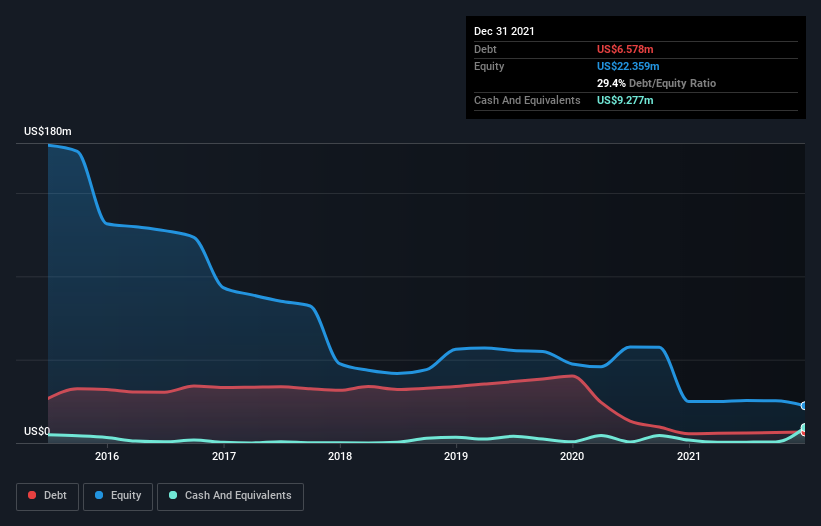Here's Why Tethys Petroleum (CVE:TPL) Has A Meaningful Debt Burden
Legendary fund manager Li Lu (who Charlie Munger backed) once said, 'The biggest investment risk is not the volatility of prices, but whether you will suffer a permanent loss of capital.' When we think about how risky a company is, we always like to look at its use of debt, since debt overload can lead to ruin. As with many other companies Tethys Petroleum Limited (CVE:TPL) makes use of debt. But the real question is whether this debt is making the company risky.
What Risk Does Debt Bring?
Debt assists a business until the business has trouble paying it off, either with new capital or with free cash flow. In the worst case scenario, a company can go bankrupt if it cannot pay its creditors. While that is not too common, we often do see indebted companies permanently diluting shareholders because lenders force them to raise capital at a distressed price. By replacing dilution, though, debt can be an extremely good tool for businesses that need capital to invest in growth at high rates of return. The first step when considering a company's debt levels is to consider its cash and debt together.
See our latest analysis for Tethys Petroleum
What Is Tethys Petroleum's Debt?
You can click the graphic below for the historical numbers, but it shows that as of December 2021 Tethys Petroleum had US$6.58m of debt, an increase on US$5.55m, over one year. But on the other hand it also has US$9.28m in cash, leading to a US$2.70m net cash position.
How Strong Is Tethys Petroleum's Balance Sheet?
Zooming in on the latest balance sheet data, we can see that Tethys Petroleum had liabilities of US$35.0m due within 12 months and liabilities of US$16.6m due beyond that. Offsetting these obligations, it had cash of US$9.28m as well as receivables valued at US$3.72m due within 12 months. So it has liabilities totalling US$38.6m more than its cash and near-term receivables, combined.
Tethys Petroleum has a market capitalization of US$65.4m, so it could very likely raise cash to ameliorate its balance sheet, if the need arose. However, it is still worthwhile taking a close look at its ability to pay off debt. Despite its noteworthy liabilities, Tethys Petroleum boasts net cash, so it's fair to say it does not have a heavy debt load!
Notably, Tethys Petroleum made a loss at the EBIT level, last year, but improved that to positive EBIT of US$4.9m in the last twelve months. There's no doubt that we learn most about debt from the balance sheet. But you can't view debt in total isolation; since Tethys Petroleum will need earnings to service that debt. So when considering debt, it's definitely worth looking at the earnings trend. Click here for an interactive snapshot.
Finally, a company can only pay off debt with cold hard cash, not accounting profits. While Tethys Petroleum has net cash on its balance sheet, it's still worth taking a look at its ability to convert earnings before interest and tax (EBIT) to free cash flow, to help us understand how quickly it is building (or eroding) that cash balance. Considering the last year, Tethys Petroleum actually recorded a cash outflow, overall. Debt is far more risky for companies with unreliable free cash flow, so shareholders should be hoping that the past expenditure will produce free cash flow in the future.
Summing up
Although Tethys Petroleum's balance sheet isn't particularly strong, due to the total liabilities, it is clearly positive to see that it has net cash of US$2.70m. So while Tethys Petroleum does not have a great balance sheet, it's certainly not too bad. The balance sheet is clearly the area to focus on when you are analysing debt. However, not all investment risk resides within the balance sheet - far from it. For example - Tethys Petroleum has 2 warning signs we think you should be aware of.
At the end of the day, it's often better to focus on companies that are free from net debt. You can access our special list of such companies (all with a track record of profit growth). It's free.
Have feedback on this article? Concerned about the content? Get in touch with us directly. Alternatively, email editorial-team (at) simplywallst.com.
This article by Simply Wall St is general in nature. We provide commentary based on historical data and analyst forecasts only using an unbiased methodology and our articles are not intended to be financial advice. It does not constitute a recommendation to buy or sell any stock, and does not take account of your objectives, or your financial situation. We aim to bring you long-term focused analysis driven by fundamental data. Note that our analysis may not factor in the latest price-sensitive company announcements or qualitative material. Simply Wall St has no position in any stocks mentioned.

 Yahoo Finance
Yahoo Finance 
